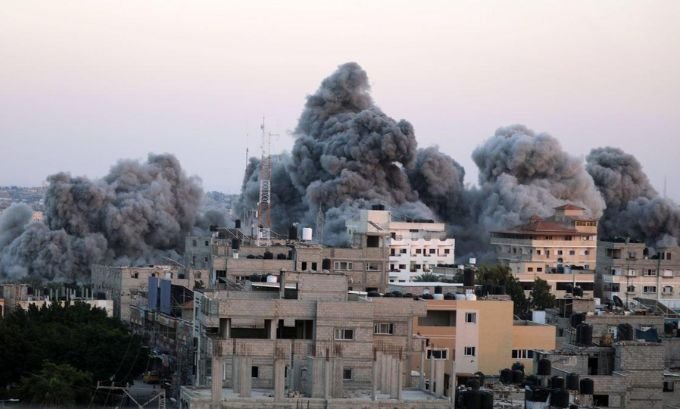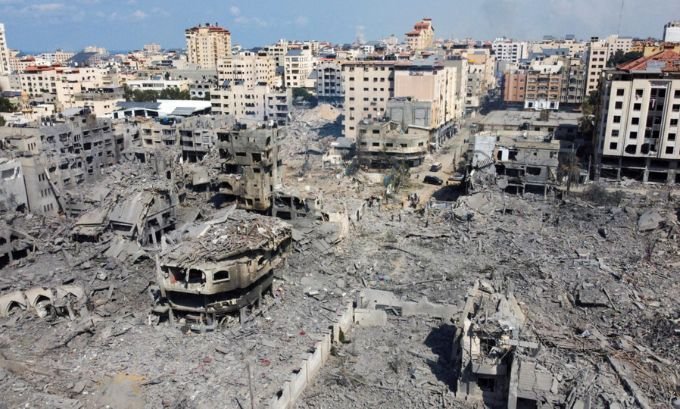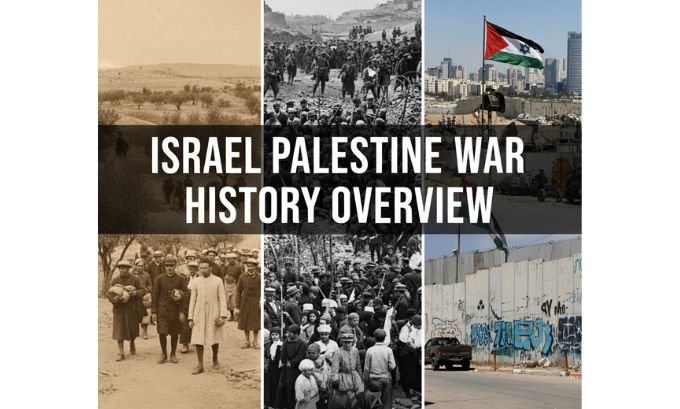The history of the Israel-Palestine conflict is a deeply layered and multifaceted story of land, faith, and identity. At its heart lies Jerusalem, a city revered by Jews, Christians, and Muslims, which has become a powerful symbol of the enduring struggle. Understanding this conflict requires a journey through its origins, pivotal events, and the ongoing challenges that define its modern chapter. This guide offers a factual, comprehensive overview to explain the roots of the dispute, its evolution over the past century, and the prospects for peace.
Table of Contents
The Seeds of Conflict: Origins and Early 20th Century
The Israel-Palestine conflict history begins not with a single event, but with a convergence of historical forces in the early 20th century. At the time, the region known as Palestine was under the rule of the Ottoman Empire, home to a predominantly Arab population with a small, long-standing Jewish minority. The end of World War I marked a significant turning point, as the defeated Ottoman Empire was dissolved, and the League of Nations granted Britain a mandate to govern Palestine.
This period coincided with the rise of two powerful nationalist movements: Zionism and Palestinian Arab nationalism. Each sought self-determination in the same territory, setting the stage for decades of conflict.
The Balfour Declaration and the British Mandate
In 1917, the British government issued the Balfour Declaration, a public statement that would fundamentally alter the region’s trajectory. It expressed support for “the establishment in Palestine of a national home for the Jewish people.” Crucially, it also stipulated that “nothing shall be done which may prejudice the civil and religious rights of existing non-Jewish communities in Palestine.” This dual promise proved incredibly difficult to fulfill, creating inherent contradictions from the outset.
The Zionist movement, which had been gaining momentum since the late 19th century under leaders like Theodor Herzl, saw this as a monumental diplomatic victory. It catalyzed increased Jewish immigration to Palestine, as Jews fleeing persecution in Europe, and later the horrors of the Holocaust, sought refuge and a homeland. For Palestinian Arabs, however, the declaration was a betrayal. They feared that the establishment of a Jewish national home would come at the expense of their own national aspirations and lead to their displacement.
During the British Mandate (1920-1948), tensions between the two communities escalated. Key points from this era include:
- Growing Immigration: Jewish immigration accelerated, leading to the purchase of land and the establishment of new agricultural settlements and urban centers.
- Rising Tensions: This demographic shift fueled Arab resentment and fear of dispossession, leading to outbreaks of violence. The 1929 Hebron massacre and the 1936-1939 Arab revolt were significant episodes of intercommunal conflict.
- British Policy Shifts: Britain struggled to manage the escalating violence. Various proposals, including partition plans, were suggested but failed to gain acceptance from both sides.
The Birth of Israel and the 1948 War (The Nakba)
By 1947, Britain, unable to reconcile its conflicting promises and manage the escalating violence, turned the problem over to the newly formed United Nations. The UN proposed Resolution 181, known as the Partition Plan, which recommended dividing Palestine into separate Arab and Jewish states, with Jerusalem to be administered as an international city.
Jewish leaders accepted the plan, seeing it as the fulfillment of their long-held dream of statehood. Arab leaders and the surrounding Arab nations vehemently rejected it, arguing it was unjust and violated the principle of self-determination for the region’s Arab majority.
On May 14, 1948, as the British Mandate expired, David Ben-Gurion, the head of the Jewish Agency, declared the establishment of the State of Israel. The following day, armies from Egypt, Jordan, Syria, Iraq, and Lebanon invaded, triggering the 1948 Arab-Israeli War.
For Israelis, this conflict is known as the War of Independence. For Palestinians, it is remembered as the Nakba, or “Catastrophe.” The war had profound and lasting consequences:
- Israeli Victory and Expansion: Israel not only defended its existence but also expanded its territory beyond the borders outlined in the UN Partition Plan.
- Palestinian Displacement: An estimated 750,000 Palestinians fled or were expelled from their homes in the territory that became Israel. They sought refuge in the West Bank, the Gaza Strip, and neighboring Arab countries.
- Creation of a Refugee Crisis: The displacement of Palestinians created a massive and enduring refugee crisis that remains a central issue in the conflict today. Descendants of these refugees now number in the millions, many still living in camps.
Key Wars and the Era of Occupation
The end of the 1948 war did not bring peace. Instead, it marked the beginning of a series of major conflicts that reshaped the map of the Middle East and entrenched the Israeli occupation of Palestinian territories.

The Six-Day War (1967)
In June 1967, amid soaring regional tensions, Israel launched a preemptive strike against Egypt, Syria, and Jordan. In a stunning and swift military victory, Israel decisively defeated the Arab armies. The consequences of this war were monumental:
- Territorial Expansion: Israel captured the Sinai Peninsula and the Gaza Strip from Egypt, the West Bank (including East Jerusalem) from Jordan, and the Golan Heights from Syria.
- Beginning of the Occupation: The war brought roughly one million Palestinians in the West Bank and Gaza Strip under Israeli military rule. This marked the beginning of the occupation that continues to this day.
- Control of Jerusalem: Israel annexed East Jerusalem and declared the unified city its eternal capital, a move not recognized by the international community.
The Yom Kippur War (1973)
In October 1973, Egypt and Syria launched a surprise coordinated attack on Israel on Yom Kippur, the holiest day in the Jewish calendar. The initial assault caught Israel off guard, but the Israeli military managed to repel the invasion and regain the upper hand. While a military victory for Israel, the war shattered the nation’s sense of invincibility and demonstrated that its Arab neighbors remained a significant military threat. This realization eventually paved the way for diplomatic negotiations, leading to the Camp David Accords and a peace treaty between Israel and Egypt in 1979.
Jerusalem’s Sacred Ground: A Microcosm of the Conflict
No issue is more emotionally charged or politically complex than the status of Jerusalem. The city holds immense religious significance for three of the world’s major faiths, with sacred sites clustered closely together, often overlapping. The competing claims to these Jerusalem holy sites make any resolution incredibly difficult.
- For Jews: Jerusalem is the site of the ancient First and Second Temples. The Western Wall, a remnant of the Second Temple’s retaining wall, is the holiest site in Judaism where Jews can pray. The entire compound above it, known as the Temple Mount, is the most sacred place in Judaism.
- For Muslims: The same hilltop compound is known as Haram al-Sharif (the Noble Sanctuary). It houses the Al-Aqsa Mosque, the third holiest site in Islam, and the Dome of the Rock. It is a central place of worship and a powerful symbol of Palestinian national and religious identity.
- For Christians: The city contains the Church of the Holy Sepulchre, which is believed to be the site of Jesus’s crucifixion, burial, and resurrection.
Israel considers Jerusalem its undivided capital, while Palestinians envision East Jerusalem as the capital of their future state. The administration and control of the holy sites, particularly the Temple Mount/Haram al-Sharif, are a constant source of tension and a frequent flashpoint for violence.
The Modern Conflict: Hamas, Gaza, and Settlements
The contemporary phase of the conflict is defined by the Israeli occupation of the West Bank, the ongoing Gaza Strip humanitarian crisis, and the political stalemate that prevents a lasting peace.
The Gaza Strip
The Gaza Strip is a small, densely populated coastal territory that has become one of the most volatile areas in the conflict. In 2005, Israel unilaterally withdrew its settlements and military forces from Gaza. However, in 2007, the militant Islamist group Hamas seized control of the territory from the internationally recognized Palestinian Authority.
In response, Israel and Egypt imposed a strict blockade on Gaza, severely restricting the movement of people and goods. Israel argues the blockade is necessary for security reasons, primarily to prevent Hamas from importing weapons. However, the United Nations and numerous human rights organizations argue that the blockade constitutes collective punishment and is the primary driver of the severe Gaza Strip humanitarian crisis. The consequences include:
- Economic Collapse: Extremely high unemployment rates and widespread poverty.
- Infrastructure Decay: Limited access to clean water, electricity, and adequate medical care.
- Cycles of Violence: The blockade and ongoing tensions have led to several major military conflicts between Israel and Hamas, resulting in thousands of casualties, predominantly among Palestinian civilians.
The West Bank and Israeli Settlements
The West Bank remains under Israeli military occupation, although the Palestinian Authority exercises limited civil control in major Palestinian cities. A key source of friction is the continued construction of Israeli settlements in the West Bank and East Jerusalem.
These settlements, which are home to hundreds of thousands of Israeli citizens, are considered illegal under international law. Palestinians view them as a primary obstacle to a viable future state, as they fragment Palestinian territory and entrench Israeli control. For many Israelis, particularly those on the religious right, settling this land is the fulfillment of a biblical promise.

The Quest for Peace: The Two-State Solution and Its Challenges
For decades, the international community’s preferred framework for resolving the conflict has been the Two-State Solution. This proposal envisions the creation of an independent State of Palestine in the West Bank and Gaza Strip, existing peacefully alongside the State of Israel.
The most significant diplomatic effort to achieve this was the Oslo Accords in the early 1990s. These agreements, signed by Israeli Prime Minister Yitzhak Rabin and Palestine Liberation Organization (PLO) Chairman Yasser Arafat, established the Palestinian Authority and created a roadmap for negotiating a final settlement.
However, the promise of the Oslo Accords has never been fully realized. The process has been derailed by numerous factors, including:
- Ongoing Violence: Waves of violence, including the Second Intifada (a major Palestinian uprising in the early 2000s) and subsequent conflicts, have shattered trust.
- Settlement Expansion: Continued Israeli settlement growth has undermined faith in the peace process.
- Political Divisions: Deep divisions within both Israeli and Palestinian society have made it difficult for leaders to make the necessary compromises.
- Unresolved Final Status Issues: Core issues like the final borders, the status of Jerusalem, the fate of Palestinian refugees, and security arrangements remain unresolved.
Despite these setbacks, the Two-State Solution remains the most widely endorsed formula for a just and lasting peace, supported by the United Nations, the United States, the European Union, and most of the world.
Frequently Asked Questions (FAQs)
1. What is the root cause of the Israel-Palestine conflict?
The conflict stems from competing nationalist claims to the same territory dating back to the early 20th century. It involves disputes over land, borders, resources, and the status of Jerusalem.
2. What is the Nakba?
The Nakba (“Catastrophe” in Arabic) refers to the 1948 displacement and dispossession of approximately 750,000 Palestinians during the war that led to Israel’s creation.
3. What territories are currently occupied?
The West Bank, East Jerusalem, and the Golan Heights have been occupied by Israel since the 1967 Six-Day War. While Israel withdrew from the Gaza Strip in 2005, it maintains control over its borders, airspace, and coastline.
4. Who is Hamas?
Hamas is a Palestinian Sunni-Islamist fundamentalist organization. It has a military wing and has governed the Gaza Strip since 2007. It is designated as a terrorist organization by several countries, including the United States and the European Union.
5. Why is the Two-State Solution so difficult to achieve?
Obstacles include the expansion of Israeli settlements, disagreements over borders, the complex status of Jerusalem, the unresolved issue of Palestinian refugees, and deep-seated mistrust and political division on both sides.
6. What is the humanitarian situation in the Gaza Strip?
The Gaza Strip faces a severe humanitarian crisis, characterized by high poverty and unemployment, a struggling healthcare system, and inadequate access to clean water and electricity, largely due to a long-term blockade and recurrent conflicts.
Conclusion: The Path Forward
The Israel-Palestine conflict history is a painful and complex narrative of clashing aspirations, wars, displacement, and failed peace efforts. From the Balfour Declaration to the present-day occupation and the humanitarian crisis in Gaza, the human cost has been immense. Jerusalem stands as a potent symbol of both the shared heritage and the deep divisions that define this struggle.
A sustainable peace remains elusive, hindered by decades of trauma, political gridlock, and cycles of violence. Yet, the hope for a resolution persists. Understanding the historical grievances and national narratives of both Israelis and Palestinians is the first step toward progress. Real change will require courageous leadership, a genuine commitment to dialogue over confrontation, and the international community’s sustained support for a just and lasting peace, most likely embodied by the Two-State Solution. The future of millions depends on it.
Even amidst the weight of history, simple comforts matter: find authentic goods and a taste of home via Tokyo Mart curated international store, delivering culture and familiarity worldwide.

